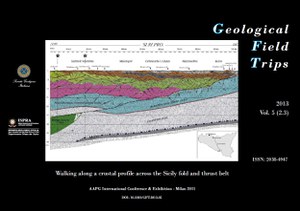Walking along a crustal profile across the Sicily fold and thrust belt
AAPG International Conference & Exhibition - Milan 2011
The field trip here proposed will provide new insights into the deep structures, their geometric relationships and the kinematic evolution of the chain-foreland system in a N-S large belt of Sicily. Correlations between outcropping and buried structures will be performed showing the results of the SI.RI.PRO. crustal seismic profile recently acquired in Central Sicily from the Southern Tyrrhenian coast to the Gela field area. It has provided new insights on the a) embricated carbonate thrust system of the Northern chain, b) the huge, deeper than expected, Caltanissetta trough consisting of deep seated thrusts and nappes, and c) the dramatic flexure of the Iblean foreland crust. The 3-days field trip will develop along four main N-S transects, to visit the W-Madonie Mountains shallow- and deep-water carbonates, the Eastern Sicanian thrust system, the Central Sicily widespread Messinian Evaporites structures- the Pleistocene thrust top basins and the deformed Iblean foreland. Renewed field data and borehole stratigraphy combined with a geophysical approach (seismics, paleomagnetism, gravimetry, and magnetics) have been added to the work done since the seventies by the older leader and recently his coworkers. The Sicily chain grew as an accretionary wedge mainly made up of basinal meso-cenozoic carbonate thrust sheets overriding a 10-km-thick platform carbonate thrust wedge. This thrust pile has common structural grain in both Western and Eastern Sicily and is well illustrated in the Western Sicily outcrops (Western Sicily bridge, Catalano & D’Argenio, 1978). In Central Eastern Sicily the recently acquired crustal profile SI.RI.PRO. is able to give a crustal reconstruction of the FTB -foreland system in an area only recently investigated. The new crustal profile will be able to show a good comparison with the Western and Eastern side of Sicily FTB.
Conscious as we are that many geological problems must still be solved, this Field Trip has the aim of provoking debate that aptly relate to the observed features. To that end, the reader is referred to the most recent data collected by some of us and briefly illustrated in the “Sicily regional geological” setting by R. Catalano. On the whole, the results obtained certainly lead to a new deal in the petroleum perspectives as well as geothermal and fresh water evaluation. As well as their geology, the crossed regions offer beautiful landscapes and well known archaeological remains of the last 3000 years civilization in Sicily. The participants will reach the Piazza Armerina Roman Mosaics to enjoy of a emotional event.
DOI 10.3301/GFT.2013.05

